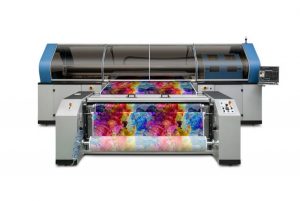Mimaki Europe announces the addition of two new high performance textile printers to its product portfolio: The Mimaki TS100-1600 and the Mimaki Tiger-1800B MkIII Printer.

Add digital print technology to meet changing market demands
The TS-100-1600 is Mimaki’s latest addition to its ‘100 series’ portfolio. This affordable, high-quality system is ideal for printers looking to add their first digital sublimation printing solution or expand their production capacity.
Bert Benckhuysen, Senior Product Manager at Mimaki Europe explained, “The textile printing industry has seen a growing requirement for increased product variety, lower inventories and shorter delivery times. Add to that the economic challenges of 2020 and we recognized that the market needed a digital textile printer that combined high quality, on-demand output with a low initial investment and cost-effective production. Having seen the success of our 100 series printers for the same reasons in other sectors, we knew that introducing a textile printer to this range would provide our customers with an opportunity to expand their businesses and seek new revenue opportunities, even amid these challenging times.”
Available in the EMEA from April 2021, the TS 100-1600 has a print width of 1,600 mm and speed of 70 m²/hour in the fastest mode. In addition, the use of a one litre ink bottle helps reduce the running cost and enables stable, continuous operation due to the reduced need for ink replacement. The printer is also equipped with a variety of renowned Mimaki features, including NCU (Nozzle Check Unit)1, NRS (Nozzle Recovery System)2, and the DAS (Dot Adjustment System) function which automates dot position correction and feeding amount correction, reducing the need for operator intervention. While the RIP software RasterLink 7 comes as standard, printers purchasing the TS100-1600 can also choose to add the TxLink4, another one of Mimaki’s original RIP software platforms.
New and improved Tiger-1800B MkIII
The second printer launched is the Tiger-1800B MkIII, the latest model of this high-speed, high-volume industrial textile printer range. Available as a high-quality direct-to-textile (reactive or direct sublimation) or sublimation transfer printing solution, the new Tiger-1800B MkIII has been developed with reliability and print accuracy at the forefront of the design process and features new software capabilities that help to increase productivity and reduce downtime.
“The textile industry is fast-moving, highly creative and leaves little room for error,” continued Benckhuysen. “Printers in this market require a robust system that will deliver the speed, quality and innovation needed to keep pace with this exciting industry. The new capabilities of the Tiger-1800B MkIII build on those featured in our predecessor models to meet these requirements head on.”
The new capabilities of the Tiger-1800B MkIII Printer include the ‘Mimaki Printer Controller’ (MPC) software. This platform has been designed for ease-of-use and enables users to set up, operate and output data with one-touch, simple operation. Its intuitive interface and functionality allow users to easily run automated overnight operation by sending multiple jobs with different settings to the print queue. The nozzle recovery function further reduces downtime by allowing production to continue if the printer encounters a nozzle malfunction.
The Tiger-1800B MkIII is also supported by the latest ‘TxLink4’ software. Its new ‘Parallel RIP function’ can manage multiple sets of print data at once to maximise productivity and the ‘Variable print function’ provides printers with the flexibility to produce more innovative, creative apparel applications. This latest system has also been upgraded with 16-bit rendering to enable a smoother gradation expression and can handle high-speed data transfer thanks to its 10 GB-based Ethernet controller.










